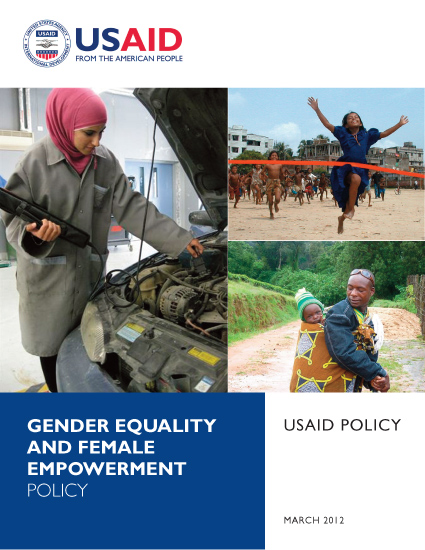Executive Summary
Gender equality and female empowerment are core development objectives, fundamental for the realization of human rights and key to effective and sustainable development outcomes. No society can develop successfully without providing equitable opportunities, resources, and life prospects for males and females so that they can shape their own lives and contribute to their families and communities. Although many gender gaps have narrowed over the past two decades, substantial inequalities remain across all sectors in which USAID works, particularly in lowincome and conflictaffected countries and among disadvantaged groups.
USAID has a long history of supporting programming to increase gender equality. Over the past few years alone, changes to the Automated Directives System (ADS), revised technical competencies required for Foreign Service backstops, new definitions of gender issues for budget attribution, new senior positions devoted exclusively to gender equality and female empowerment, and new common indicators to measure progress in this arena have strengthened the Agency’s ability to address key gender issues and track our progress in doing so. Still, an updated Agency policy on gender equality and female empowerment was needed to reflect fundamental changes in the world and the evidence that has accumulated since the 1982 Policy Paper on Women in Development was issued. In 2012, USAID issued a new comprehensive policy on Gender Equality and Female Empowerment that builds on the Agency’s progress to date.
The goal of this policy is to improve the lives of citizens around the world by advancing equality between females and males, and empowering women and girls to participate fully in and benefit from the development of their societies. It will be addressed through integration of gender equality and female empowerment throughout the Agency’s Program Cycle and related processes: in strategic planning, project design and implementation, and monitoring and evaluation. This integrated approach positions the Agency to address gender gaps and the constraints that hold women back.
Under this policy, USAID investments are aimed at three overarching outcomes. In strategic planning at the country or project level, these outcomes will be adapted and translated into specific results with associated targets and indicators. These outcomes, which are especially important for people who are marginalized or excluded due to ethnicity, gender identity, sexual orientation, lack of income, disability or other factors, reflect the gamut of activities that USAID undertakes across multiple sectors and fields:
- Reduce gender disparities in access to, control over and benefit from resources, wealth, opportunities and services economic, social, political, and cultural;
- Reduce gender-based violence and mitigate its harmful effects on individuals and communities; and
- Increase capability of women and girls to realize their rights, determine their life outcomes, and influence decisionmaking in households, communities, and societies.








Comment
Make a general inquiry or suggest an improvement.